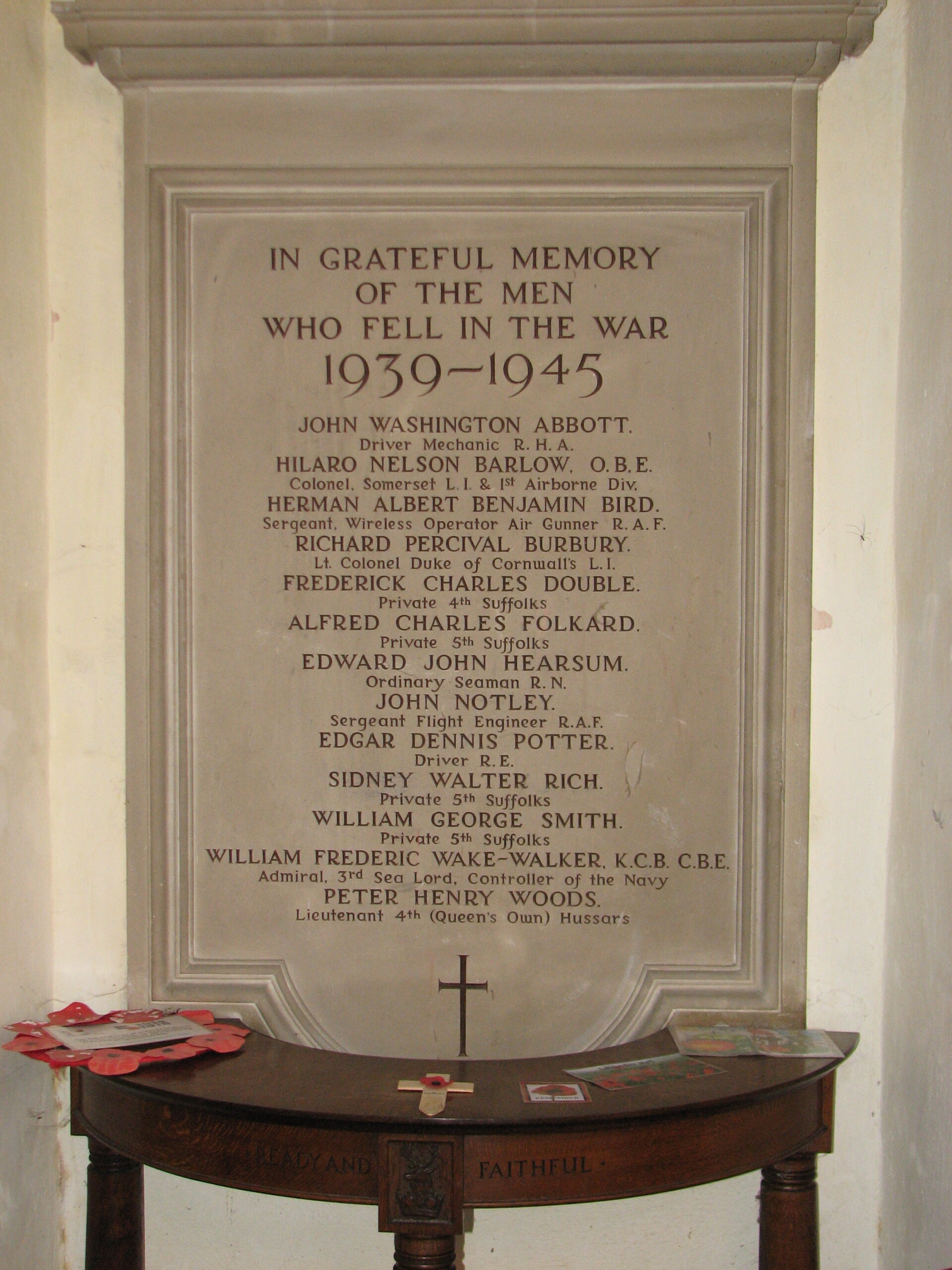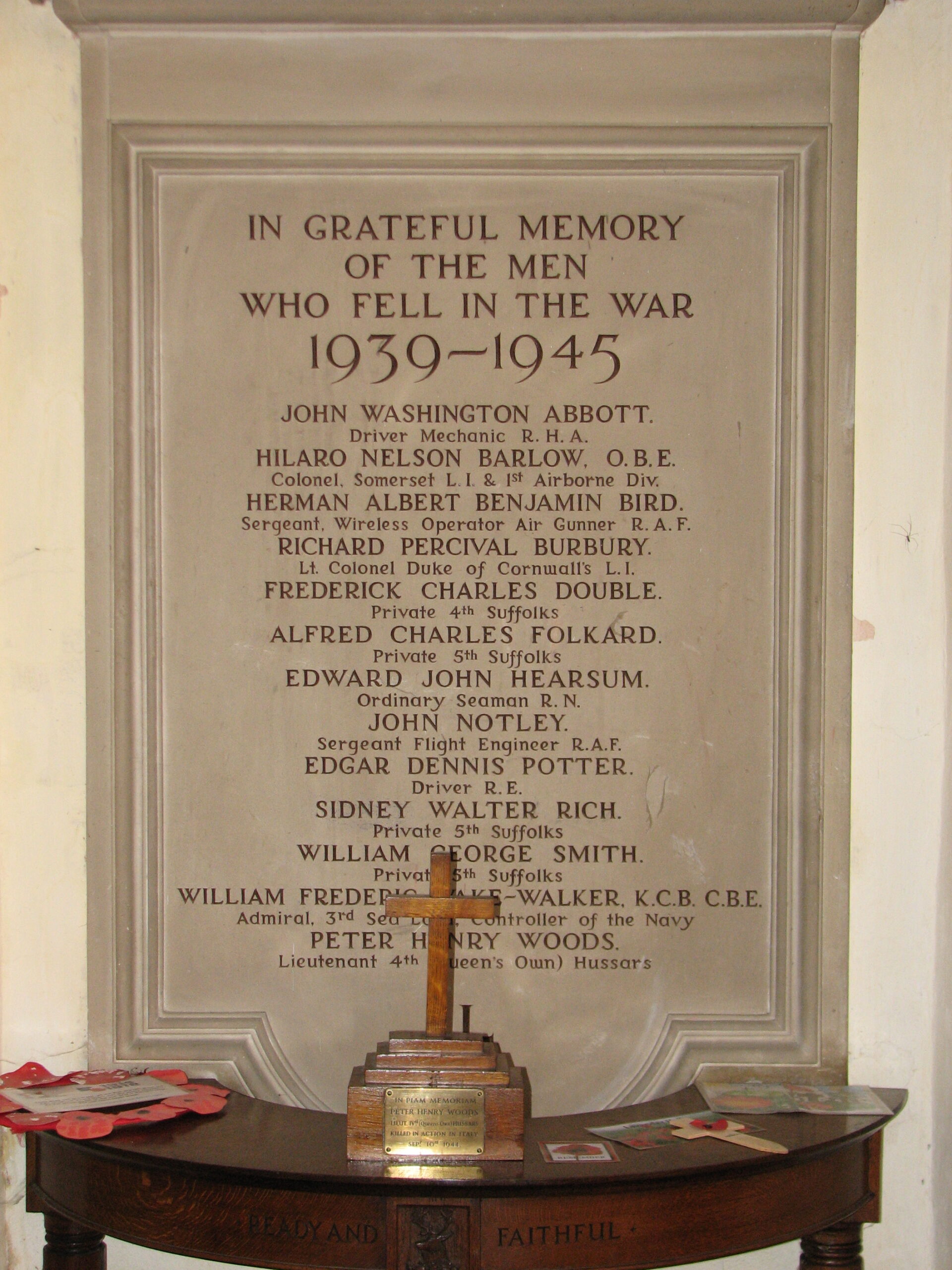Second World War Memorial
Unveiled on Remembrance Sunday 1948, the Village Memorial to those who Gave Their Lives in the Second World War can be found in the South Alcove of St. Mary’s Church. It contains the names of 13 men from the village (or whose close family lived in the village) who lost their lives in that War.
- 7
- The Village Memorial to those who died in the Second World War
- 51.969988, 1.012786
Details
The Village’s Memorial to those who Died in the Second World War was unveiled on 7th November 1948 – Remembrance Sunday – by Mrs Emily Folkard, whose son died in the War. It was dedicated by the Rector of St. Mary’s, the Reverand Charles W. Barlow.
The Memorial
The Memorial was designed by the Ipswich architect Henry Munro Cautley and agreed by both the Parish Council and the Diocese. 1 Henry Munro Cautley’s other work includes the Ipswich Central Library on Northgate Street and also The Walk shopping arcade in Ipswich, which he designed with his colleague Leslie Barefoot. The Stonemason was Saunders of Ipswich. Its cost was met by an appeal to Parishioners, and any surplus funds were donated to the Royal British Legion Benevolent Fund.
Initially, there had been talk about placing the Memorial underneath the Great War Memorial, but that was found to be impractical. It was then decided to place it in the South Alcove, which was adjacent to the Great War Memorial.
First however, an existing stone tablet commemorating the Zeppelin attack on the village in 1915 and also one of the bombs that had been dropped, had to be removed. Their current location is not known.
Just under one month before the unveiling, Lady Ann Wake-Walker gave a table to be placed under the Memorial. Unfortunately, the original table was stolen in 1990 and a replacement was commissioned by Captain Christopher Wake-Walker R.N. (Lady Anne’s husband).
On top of that table sits a small wooden Cross to the memory of one of the men commemorated on the Memorial, Peter Woods.
Statistics and “Cold” Facts
An analysis of the men commemorated on the Memorial reveals that:
- 11 of the men are known to have lived in East Bergholt at some point in their lives.
- 2 of the men (who were cousins) did not actually live in the village at all. Their connection with East Bergholt is that the parents of one of them (and thus the aunt and uncle of the other) lived in the village during – and after – the War.
- At the time of writing (2024) the exact nature of the link between the village and one of the men commemorated on the Memorial (John Notley) has not yet been established. It is known that he was not born in East Bergholt, but evidence has so far been found of close family connections to Mistley and Brantham.
- 7 of the men were born in East Bergholt.
- 9 of the men served in the British Army, 2 served in the Royal Navy and 2 served in the Royal Air Force.
- The only family relationship between the men commemorated on the Second World War Memorial is that two of them were cousins. This is in stark contrast to the family relationships that existed between many of the men commemorated on the adjacent Great War Memorial.
- 6 of the men died in the Far East.
- 4 of the men died in the North-West Europe theatre of operations.
- 1 man died in North Africa.
- 1 man died in Italy.
- 1 man died in the UK.
- 4 of the men died in 1942.
- 4 of the men died in 1943.
- 4 of the men died in 1944.
- 1 man died in 1945.
- 2 of the men were aged 19 when they died.
- 6 of the men were aged 20 to 25, when they died.
- 2 of the men were aged 26 to 30, when they died.
- 2 of the men were aged 31 to 40, when they died.
- 1 man was aged over 40, when he died.
- 6 of the men have “no known grave” and are officially commemorated on Commonwealth War Graves Commission Memorials to the Missing.
- The first of the men to die, was killed in January 1942; the last, died in September 1945.
- 2 of the men are recorded as dying on the same day – 27th October 1943 – albeit this is a coincidence. Both men died as Japanese prisoners, but they were in different camps situated many miles apart.
Copyright © Mark Ashmore, 2024
- 7
- The Village Memorial to those who died in the Second World War
- 51.969988, 1.012786


